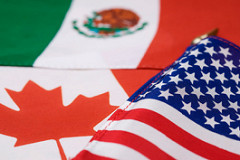clear
How can the wall impact the North American Free Trade Agreement?
clear

source:
asadullah2nd / Flickr
The North American Free Trade Agreement (NAFTA) entered into force on January 1, 1994.
One of the main arguments in favor of NAFTA at the time it was being proposed by policymakers was that the agreement would improve economic conditions in Mexico and narrow the income disparity between Mexico and the United States and Canada. Studies that have addressed the issue of economic convergence have noted that economic convergence in North America has failed to materialize.
One study states that NAFTA failed to fulfill the promise of closing the Mexico-U.S. development gap and that this was partially due to the lack of deeper forms of regional integration or cooperation between Mexico and the United States.
The study contends that domestic policies in both countries, along with underlying geographic and demographic realities, contribute to the continuing disparities in income. The authors argue that neither Mexico nor the United States adopted complementary policies after NAFTA that could have promoted a more successful regional integration effort. These policies could include education, industrial policies, and more investment in border and transportation infrastructure.
The authors also note that other developments, such as increased security along the U.S.-Mexico border after the September 11, 2001, terrorist attacks, have made it much more difficult for the movement of goods and services across the border and for improving regional integration. They argue that the two countries could cooperate on policies that foster convergence and economic development in Mexico instead of increasing security and "building walls.
 0
0
clear